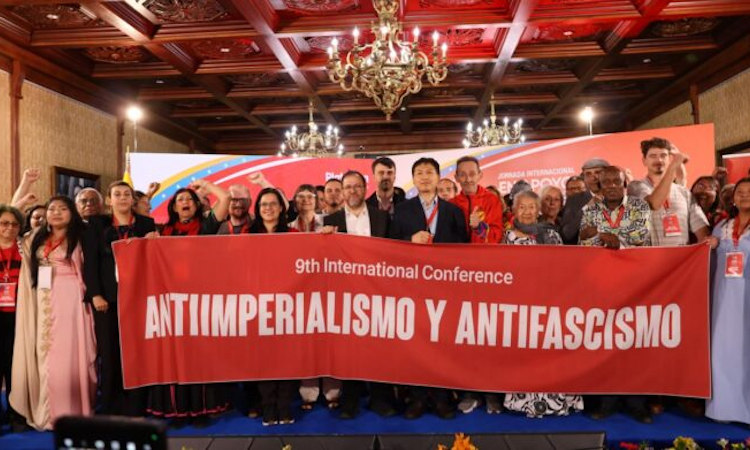Download this leaflet as a pdf.
Vladimir Ilyich Ulyanov, known to us as Lenin, was a Russian Marxist who is best known for leading the 1917 October Revolution that brought socialism to Russia and to the territories of the former Russian empire, leading to the foundation and building of the world’s first great socialist state, the Union of Soviet Socialist Republics (USSR).
A life in service of the people
Lenin wasn’t just any old Russian Marxist, though. After Karl Marx and Friedrich Engels, the great founders of scientific socialism in the 19th century, VI Lenin was the single most important Marxist theoretician ever to have lived. Not only was he a brilliant student of Marxism, but he applied this philosophical, economic and political understanding in the most brilliant way to solving the problems facing the urban factory workers, the poor agricultural population and the oppressed nations suffering under tsarist rule during the period of decaying, monopoly capitalism – the period of imperialism.
Since monopoly capitalism is the economic system that still dominates our world, the answers Lenin came up with to the problems facing his own movement are still extremely relevant to workers in the west today, if we want to win our freedom from capitalist exploitation; if we want to build a world in which our children can have fulfilling lives, developing their potential, making a meaningful contribution to society, and enjoying the fruits of their labours in peace, dignity, prosperity and security.
In 30 years of political activity, Lenin left behind a huge collection of books, pamphlets, articles, speeches and letters, any page of which can give the reader a lesson in Marxist science and its application to real-world situations. But Lenin didn’t write in an ivory tower as an intellectual exercise. Having understood very young from his experience of capitalist society and his study of Marxism that the only way out of the downward spiral of poverty, crisis and war was socialism, he dedicated himself to working on bringing that change into being.
As a result, Lenin lived and breathed socialist revolution. Charged with sedition by the Russian authorities for the first time in 1896, when he was just 26 years old, he was sentenced after a year in a St Petersburg jail to three years’ exile in Siberia. On his release, he set up a distribution network for an underground all-Russian workers’ newspaper (revolutionary literature was banned by the government, so illegal means had to be found to get the information into the hands of the people) before going into exile to edit and print the paper in western Europe and then to arrange for physical copies to be smuggled back into Russia. The networks that were set up in the course of this work went on to form the basis of Russia’s Marxist party, the Russian Social-Democratic Labour Party. When that organisation split, the revolutionary wing led by Lenin become known as the Bolsheviks.
Every one of Lenin’s major works reflects his deep scientific clarity, and each one and was written to solve an urgent problem that was facing the socialist movement. In 1901, What Is To Be Done? helped revolutionary workers understand the need to develop their Marxist understanding of economics and politics and to strive to connect this scientific analysis with the growing mass movement. In the book, Lenin smashed the idea that workers in struggle would automatically arrive at a Marxist understanding through their experience of strikes and other struggles against their employers.
In 1904, One Step Forward Two Steps Back underlined the need for a special type of revolutionary organisation if the workers are going to be successful in winning through to socialism. In the book, Lenin smashed the idea that this organisation could be effective if it was loose and amorphous, proving that only the most serious discipline and commitment in the ranks of its leading institution (the communist party) would enable the working class to harness the strength of its numbers to smash the control and resistance of the capitalist class and its powerful machinery of coercion and control.
In 1909, Materialism and Empirio-Criticism, written during a period of defeat and retreat when many were ‘redefining’ or even abandoning Marxism altogether, contained a definitive defence of Marxist materialism/a> as the basis for humanity’s liberation. In the book, Lenin smashed the various falsifiers of Marxism and showed how their distortions were leading the working class into blind allies that would harm their cause and tie them to their class enemies.
During the period of the first world war, Lenin wrote a huge amount on the many ways in which fake leaders of the working class across Europe had sold out their interests. During this period he also wrote the two works for which he is most famous. The first of these was Imperialism, the Highest State of Capitalism in 1916. This book defined the monopoly stage of capitalism, in which advanced western economies had become dominated by huge trusts and cartels in every sphere of the economy, so that giant corporations had come to control every aspect of economic, political and social life, dictating government policy and controlling all the institutions of the state. Unable to make enough profit from their home economies alone, these monopolist states had grabbed territories abroad, deriving superprofits from looting their resources and exploiting their peoples.
Lenin showed how the imperialist rulers of the globe were driving the world to war in order to sustain their rule and fight over the spoils of loot from the colonies. He also showed that the economic crisis underpinning that drive to war created an instability that should be used by workers to rise up and bring down the whole rotten edifice. Lenin taught, and the Bolsheviks proved, that imperialism is the eve of the social revolution – the tipping point when the contradictions and inequalities of the capitalist system have become so extreme that the workers have no choice but to organise for socialism or sink into the utter depths of destitution and despair.
Along with this deep scientific understanding of their historic task, the Bolsheviks were inspired by the knowledge contained in another seminal work written by Lenin in 1917. Just as the socialist revolution was maturing in Russia, Lenin wrote The State and Revolution, a book that set out the Marxist teaching on the state and brought it to a new audience. With this book, Lenin smashed the idea that there was a peaceful, parliamentary road to socialism in the imperialist countries, and demonstrated conclusively that the existing state machinery, perfected to enforce the rule of a tiny exploiting minority over the vast masses of the exploited population, can never be made to serve the interest of the workers. Our job, he showed, is to smash the old state of the exploiters and to build a state of a new type, a state capable of harnessing the power and creativity of the working masses to direct the construction of a new society and a planned socialist economy.
In this way, Lenin not only solved scientifically many problems of Marxist science in the new era, but also created a practical programme for how the working people could move from being a superexploited and oppressed underclass to masters of a new world. He left us an immortal legacy of advice on how to create and build working-class revolutionary organisations; how to focus our energies on the most important tasks; how to spot the fake Marxists who try to lead our movement into useless dead ends; how to identify our allies and maximise our strengths; and how to unify many separate strands of struggle into one mighty torrent capable of sweeping away the old and building the new.
With 45 volumes of works to choose from, any number of topics could be chosen as a focus for special attention. In this small article, we will focus on just three essential lessons that have particular significance for our struggle in Britain and around the world today, when a new wave of anti-imperialist struggle is rising to face the twin threats of imperialist global economic crisis and the imperialist drive into a third world war.
Fighting against opportunism
By opportunism, we mean the selling out of the long-term interests of the workers’ movement for socialism for short-term gains, real or perceived, political or personal. According to Lenin, such manoeuvrings can ultimately be traced back to capitalist influence, ideological or financial.
“Opportunism is a manifestation of the bourgeoisie’s influence over the proletariat.”
In 1912, all the socialist parties in Europe had made a commitment to mobilise the workers in active opposition to war when it broke out, promising to do everything possible to transform an interimperialist war, in which workers slaughtered their fellow workers in the interests of the monopolists’ profits and plunder, into a civil war, in which the revolutionary workers would turn their guns against their own imperialist rulers.
But when the war broke out, most of the leaders of the supposedly Marxist parties of Europe betrayed this agreement and instead joined ‘national unity’ governments, voted for subsidies for the arms industries, and started mobilising the working class to be sent to the carnage of the trenches to kill and be killed in industrial quantities ‘for the fatherland’. During the course of WW1, social democracy (the Labour party in Britain) emerged as the primary vehicle for capitalist influence in and control over the working-class movement. Social-democratic leaders became government ministers and in every way supported and recruited for the war effort.
Lenin and the Bolsheviks were in the lead of the small group of revolutionaries in Europe who stuck firmly to the line that had been agreed on before the war. And Lenin was untiring in working to expose the treachery of all those who had sold out the interests of the workers and were leading them to their deaths instead of toward socialism. He was also adamantly opposed to those who tried to conciliate between the revolutionary and opportunist wings of the movement in the name of ‘unity’, showing how in practice these fence-sitters only served the interests of the capitalist class.
Lenin wrote extensively about the need to expose rather than cover over such important differences – about the need to break cleanly rather than trying to mend what was had long ago stopped being whole.
“The split in the labour and socialist movements throughout the world is a fact. We have two irreconcilable working-class tactics and policies in respect of the war. It is ridiculous to close your eyes to this fact. Any attempt to reconcile the irreconcilable will make all our work futile.”
The success of Lenin and the Bolsheviks in the October Revolution was based in their firm adherence to a correct line; their willingness to speak uncomfortable truths in order to educate the workers and guide the movement. No doubt many at the time considered Lenin to be ‘harsh’, ‘abrupt’, ‘bad-mannered’, ‘sectarian’ and so on, but ultimately, he was proved to be right.
Not only were the Bolsheviks successful in turning WW1 into a revolutionary war to end capitalism, establishing the world’s first socialist state and building the world’s first socialist economy, but they inspired the development of parties of the Bolshevik type all over the world. Parties that made huge contributions to the struggle for socialism and national liberation and made the decisive contribution to the defeat of fascism in WW2.
Lenin’s fight against opportunism was key to the Bolsheviks’ success in conditions of global crisis a century ago – and it will be key to our success in the coming period too.
Insisting on theory
Understanding that Marxism holds the key to the liberation of all humanity, and of the workers in particular, Lenin made it a point to conduct all his investigations from the point of view of Marxist science. And just like the Marx and Engels themselves, he never jumped to conclusions based on what he wanted to be true or what he thought would be popular. Instead, he carefully worked out what was the correct, proletarian (working-class) viewpoint on any question – and then worked tirelessly to persuade his party to accept his analysis as the basis for its programme.
This scientific approach of sifting all available evidence and examining it through the prism of Marxist materialism before deciding on a conclusion was a key contributing factor in the Bolsheviks’ stunning successes. It is an approach that continues to stand out clearly from that of the self-identifyfing fake ‘socialists’ (really bourgeois liberals) who dominate popular left-wing discourse today, just as they did in Lenin’s day. Unlike real Marxists, however, these individuals start with an ‘idea’ they wish to present as ‘progressive’ (usually something that fits neatly with some prevailing capitalist agenda) – and proceed to gather ‘evidence’ in support of their preordained conclusion, disregarding anything that does not fit with their chosen narrative.
In fact, the great efforts that the ruling classes put into creating a huge variety of fake ‘Marxist’ materials and fake ‘Marxist’ organisations just goes to show that our enemies have grasped what too many workers still have not: that Leninism, real Leninism, the science of revolutionary Marxism, holds the keys to success in the working class’s struggle for liberation.
Lenin’s insistence on theoretical clarity, and on the unity of theory and practice, on the necessity of having a thoroughly worked out scientific basis for all points of programmatic action, was key to the Bolsheviks’ success in building their party, extending its influence and educating the working class for revolutionary action – and it will be the key to our success in the coming period too.
Unifying the struggle against imperialism
Many people today are unaware that it was Lenin who applied Marxism to the generally ignored question of the colonised peoples. During the late 19th century, the national question had been treated by many Marxists as something that concerned only a few European countries such as Poland, Hungary and Ireland. The mass of colonised peoples in Asia, Africa and Latin America were generally overlooked.
Lenin broke down the artificial wall that colonialism had erected between Europeans, Asians, Africans and Latin Americans; between the ‘civilised’ and ‘uncivilised’ slaves of imperialism. With the slogan of self-determination, Lenin educated the masses in the spirit of internationalism, showing how our two struggles against the same enemy could be practically unified so as to assist and amplify one another.
Again and again, Lenin, stressed the importance of the practical unity of the struggles of the socialist revolutionaries in the imperialist heartlands and of those struggling for national liberation from the same imperialist powers abroad. In our era, said Lenin, the world is divided into two great camps: the camp of a handful of imperialist exploiting and oppressing nations, possessors of finance capital which exploit the majority of the population of the globe; and the camp of the oppressed and exploited billions.
The shared interests of the working-class movement in the imperialist heartlands and the national-liberation movement in the colonies call for a union of these two forms of revolutionary movement in a common front against imperialism – against our common enemy. Without such a front, the victory of either is impossible. During wars of national liberation waged by an oppressed people against an imperialist power, it is the duty of the workers within the oppressing country to work for the defeat of their own ruling class and the victory of the liberation fighters.
“The revolutionary movement in the advanced countries would in fact be nothing but a sheer fraud if, in their struggle against capital, the workers of Europe and America were not closely and completely united with the hundreds upon hundreds of millions of ‘colonial’ slaves, who are oppressed by that capital.”
By working out the practical solution to the national question in a scientific and revolutionary way, the demands of the oppressed nations were met in the socialists’ programme and the liberation struggles of the peoples of the Russian empire were merged with the socialist struggle of the Russian proletarians and poor peasantry. This practical union of struggle created a mighty torrent that was able to sweep away Russian imperialism.
The collapse of so many formerly harmonious socialist republics into balkanised and fratricidal statelets following the counter-revolutions of 1989-91 clearly revealed the brilliance of Lenin’s approach to the national question. While the Soviet Union existed, national oppression and conflict were replaced by cooperation and assistance. Having unleashed the huge potential of its population and resources through the tremendous power of the all-Union planned economy, the USSR went on to grow at a pace unprecedented in human history, replacing exploitation and colonial slavery with peace and prosperity for all.
Lenin’s insistence on forging the closest possible unity between proletarians in the imperialist countries and the oppressed and colonised masses in the rest of the world was vital to the successful overthrow of Russian imperialism and the building of a strong and resilient socialist economy – and it will be equally vital in our struggle against the US-led imperialist bloc in the coming period.














